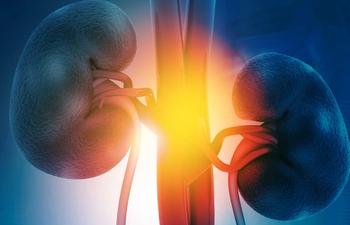
Oncology NEWS International
- Oncology NEWS International Vol 10 No 11
- Volume 10
- Issue 11
Radiofrequency Ablation Proving Effective in Small Renal Cell Tumors
ANAHEIM, California-Percutaneous radiofrequency ablation, which is FDA-approved for treating liver and soft tissue neoplasms, may also be useful in renal cell carcinoma, according to several reports from the American Urological Association annual meeting.
ANAHEIM, CaliforniaPercutaneous radiofrequency ablation, which is FDA-approved for treating liver and soft tissue neoplasms, may also be useful in renal cell carcinoma, according to several reports from the American Urological Association annual meeting.
Investigators from both the National Cancer Institute and Harvard Medical School concluded that the procedure is a safe and minimally invasive option for the treatment of select, small renal neoplasms, although more rigorous long-term follow-up is necessary before routinely adopting this modality.
"Small renal cell carcinomas are being detected at an ever-increasing rate, mostly in persons having CT scans for other purposes," said Francis J. McGovern, MD, of Harvard Medical School and Massachusetts General Hospital.
These are often early-stage cancers that are fairly easy to treat. "But we are also finding incidental renal tumors in older patients with multiple comorbidities. These patients are often limited to watchful waiting, which can be quite anxiety provoking. Radiofrequency ablation offers a treatment option to patients who are at high surgical risk," he said.
Dr. McGovern and his colleagues (abstract 645) evaluated the safety and efficacy of radiofrequency interstitial tumor ablation in 17 patients with 19 renal cell tumors ranging from 1 to 5.5 cm.
Ablations were performed as outpatient procedures using intravenous sedation and an internally cooled radiofrequency electrode, with image guidance by ultrasound or CT scan. Responses were evaluated by contrast-enhanced CT or MRI, and follow-up averaged 3.5 years.
In 18 tumors treated with curative intent, complete responses were seen in 15 lesions and partial responses in the remaining 3 lesions. In all complete responders, the tumors were peripheral or exophytic, and ranged from 1 to 3.5 cm in greatest diameter. Larger tumors in the periphery also responded well. In all partial responders, tumors were larger (4.4 to 5.5 cm) and centrally located.
All but three patients were treated as outpatients, and the procedure was generally well tolerated, Dr. McGovern said. Complications included ureteral obstruction requiring stent placement in two patients and gross hematuria/perinephric bleeding managed conservatively in one.
A similar study by NCI investigators (abstract 647), reported by Christian P. Pavlovich, MD, of the Urologic Oncology Branch, reached the same conclusion: that radiofrequency ablation is safe and well tolerated, and can be done as an outpatient procedure, but final results await long-term validation.
Dr. Pavlovich presented the results from an ongoing trial of percutaneous radiofrequency ablation for patients with small renal tumors (3 cm or smaller) demonstrating growth over 1 year. To date, the cohort includes only patients with hereditary forms of renal cancervon Hippel-Lindau and hereditary papillary renal cancer.
"Such patients require regular surveillance by abdominal imaging because of their lifelong risk of multifocal renal tumors. They undergo repeated attempts at nephron-sparing surgery over their lifetime, and these frequent operations produce morbidity and impact their quality of life," Dr. Pavlovich said. Radiofrequency ablation would offer a means of avoiding this pattern.
At least two 10-minute ablations were performed per lesion, with the patient under conscious sedation. The procedures were guided by ultrasound and/or CT imaging. Follow-up included CT scanning at baseline and at 2, 6, and 12 months along with other tests. Treatment effects were assessed based on CT appearance and pre- to postcontrast change in Hounsfield units of the treated area over time.
The study included 19 patients who had 22 solid renal tumors. Mean and median follow-up was 6 months. At treatment, the tumors were actively growing, with a mean tumor diameter of 2.4 cm and a mean change in tumor enhancement of +63 Hounsfield units.
At 6 months post-treatment, the mean lesion diameter was 1.7 cm, none of the lesions were larger than they were before treatment, and contrast enhancement was lost in most lesions. In one case, no lesion was detectable at 6 months.
Persistent enhancement appeared to be correlated with tumors that were difficult to heat due to their central or medullary locations, Dr. Pavlovich said.
All patients were discharged within 24 hours. There were no major complications, injuries to neighboring organs, perinephric hematomas, or damage to renal function by various laboratory studies. Transient psoas irritation was a rare complication seen in three patients.
"Based on 6 months of follow-up, some three quarters of renal tumors appear to be effectively ablated on CT scan," Dr. Pavlovich said. "And tumors with persistent enhancement on CT scan can be retreated."
Dr. McGovern noted: "The key finding of both these studies is that there is a very high success rate with small peripheral tumors. But we need a minimum of 5 years follow-up and more pathology follow-up."
He speculated that over time, if the results hold up, the therapy may be an option even in young patients with small peripheral lesions, especially in patients with lesions 3 cm or smaller who would be candidates for a partial nephrectomy. "These patients could still be followed, and in the worst-case scenario, if CT scans showed viable lesions, they could undergo a partial nephrectomy," he said.
Articles in this issue
about 24 years ago
Two Large AIDS Studies Will Increase Enrollments 60%about 24 years ago
Gene Therapy Plus Radiotherapy Delays Esophageal Cancer Growth in Miceabout 24 years ago
Platinum-Based Regimens Are Favored in Advanced NSCLCabout 24 years ago
Templates Used to Document Chemotherapyabout 24 years ago
Grade Dictates Treatment of Primary NHL of the Breastabout 24 years ago
Low Arsenic Levels in Drinking Water Increase Cancer Riskabout 24 years ago
Astatine-211-Labeled MoAB Promising in Brain Cancer Patientsabout 24 years ago
GEMOX Active With Low Toxicity in Pancreatic Cancerabout 24 years ago
Legislation Urged to Revitalize the National Cancer Planabout 24 years ago
Cisplatin/Gemcitabine/Herceptin Encouraging in NSCLCNewsletter
Stay up to date on recent advances in the multidisciplinary approach to cancer.
































































































